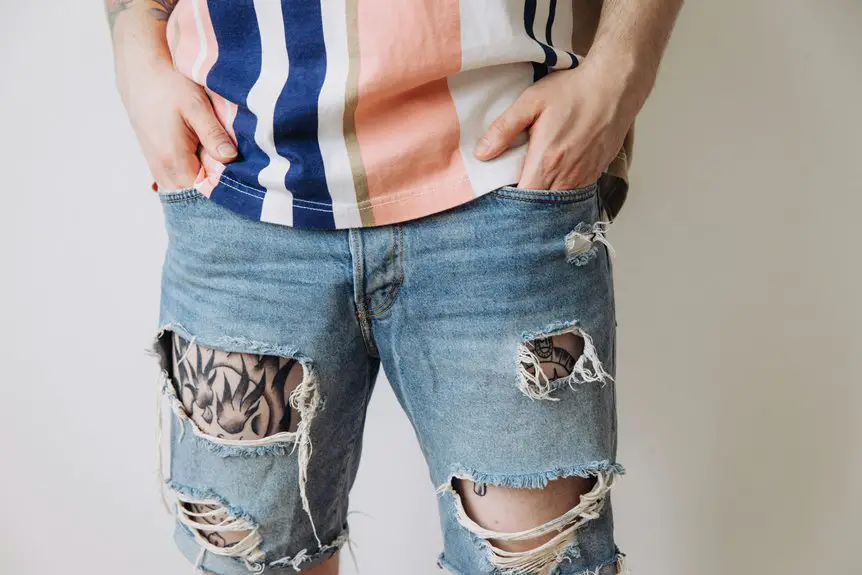When the heat turns up, it’s crucial to find fabrics that keep you feeling fresh and comfortable. You might think all summer clothes are created equal, but some materials truly shine in the heat. Understanding which fabrics can help you beat the warmth can make a significant difference in your daily comfort. So, what should you look for in your summer wardrobe? Let’s explore the options that promise to keep you cool.
Table of Contents
Key Takeaways
- Linen is highly breathable and moisture-wicking, promoting air circulation and evaporation to keep you cool in summer.
- Cotton is soft and comfortable, but opt for lighter, moisture-wicking varieties to prevent clinginess and increased heat.
- Bamboo fabric is naturally moisture-wicking and soft, helping to regulate body temperature and enhance comfort in warm weather.
- Cooling synthetics utilize advanced moisture management technologies to wick sweat away quickly, keeping you dry and cool.
- Light-colored fabrics reflect sunlight better than darker shades, further aiding in temperature regulation during hot summer days.
Understanding Cooling Fabrics
When summer heat hits, understanding cooling fabrics can make a big difference in your comfort.
Fabrics like cotton, bamboo, and moisture-wicking synthetics are designed to help you stay cool. Cotton’s breathability allows air to circulate, keeping you cooler than heavier materials. Bamboo, with its natural moisture-wicking properties, pulls sweat away from your skin, promoting evaporation.
Stay cool this summer with breathable fabrics like cotton and bamboo, designed to wick moisture and enhance airflow.
Synthetics, such as polyester and nylon, often feature advanced technology for moisture management, making them ideal for active summer days. Look for fabrics with lighter colors, as they reflect sunlight better than dark shades.
When choosing your summer wardrobe, prioritize these materials to enhance your comfort and enjoy the season without overheating. You’ll feel the difference as you embrace the summer sunshine!
The Superiority of Linen
Although many fabrics claim to keep you cool, linen stands out as a superior choice for summer wear. Its natural fibers are incredibly breathable, allowing air to circulate freely around your body. This keeps you feeling fresh, even on the hottest days.
Linen’s moisture-wicking properties help draw sweat away from your skin, promoting evaporation and reducing that sticky feeling. Plus, its loose weave creates a lightweight garment that barely clings to your body, enhancing comfort.
You’ll love how linen not only feels cool but also adds a touch of elegance to your summer wardrobe. With its durability and timeless appeal, choosing linen means you’re investing in a fabric that’ll keep you stylish and comfortable season after season.
Cotton: A Popular Yet Limited Choice
Cotton is often hailed as the go-to fabric for summer, but it has its limitations that you should consider.
While it’s soft and comfortable, cotton tends to absorb moisture rather than wick it away. When you sweat, cotton can cling to your skin, making you feel even hotter.
Additionally, its weight can vary, and heavier cotton fabrics mightn’t be the best for high temperatures. You might also find that pure cotton doesn’t dry quickly, which can leave you feeling damp and uncomfortable.
So, while cotton’s a popular choice, it’s worth exploring lighter, moisture-wicking alternatives if you want to stay cool.
Fabrics like linen or blends with synthetic fibers may serve you better during those scorching summer days.
The Role of Breathability in Fabric Selection
Choosing the right fabric goes beyond just picking something soft; breathability plays a key role in how comfortable you feel in the heat. When you select breathable fabrics, you allow air to circulate, which helps regulate your body temperature.
Selecting breathable fabrics is essential for staying cool and comfortable in the heat, as they promote air circulation and temperature regulation.
Here are three key benefits of breathable fabrics:
- Comfort: Fabrics like linen and cotton allow moisture to escape, keeping you cool and dry.
- Reduced Odor: Breathable materials let sweat evaporate, minimizing unpleasant smells.
- Freedom of Movement: Lightweight, breathable fabrics offer flexibility, making it easier to move around without feeling restricted.
Next time you shop for summer clothing, prioritize breathability to enhance your comfort and overall experience in warm weather!
Moisture Management and Its Importance
When you’re out in the summer heat, effective moisture management becomes essential.
It helps transfer sweat away from your skin, preventing heat buildup and keeping you comfortable.
Choosing the right fabrics can greatly enhance your overall experience in warm weather.
Effective Moisture Transfer
Effective moisture transfer is essential for staying comfortable during hot summer days, as it keeps sweat from clinging to your skin.
Fabrics that excel in moisture management can dramatically enhance your comfort level. When choosing your summer wardrobe, consider these three key factors:
- Breathability: Look for materials that allow air circulation, helping sweat evaporate quickly.
- Wicking Ability: Choose fabrics that draw moisture away from your skin, transferring it to the outer layer for faster evaporation.
- Drying Speed: Prioritize textiles that dry quickly, so you stay dry and cool even during peak heat.
Preventing Heat Buildup
Moisture management plays an essential role in preventing heat buildup, especially during the sweltering summer months. When you wear fabrics that wick away sweat, you’re actively reducing the moisture on your skin, which can trap heat and make you feel uncomfortable.
Natural fibers like cotton and linen are great choices because they allow air to circulate while absorbing moisture. Synthetic fabrics designed for moisture management are also effective, as they pull sweat away from your body and let it evaporate quickly.
Enhancing Comfort Levels
Staying cool during hot summer days hinges on how well your clothes manage moisture. Choosing the right fabrics can enhance your comfort by keeping sweat at bay and allowing your skin to breathe.
Here’s why moisture management is essential:
- Wicking Ability: Fabrics that wick moisture away from your skin help evaporate sweat quickly, preventing that uncomfortable sticky feeling.
- Breathability: Natural fibers, like cotton and linen, allow air to circulate, keeping you cooler and reducing the risk of overheating.
- Drying Time: Lightweight materials dry faster, so you won’t have to deal with dampness that can lead to irritation and discomfort.
Natural Fibers and Their Environmental Benefits
While many fabrics can help you stay cool in summer, natural fibers like cotton, linen, and hemp offer significant environmental benefits.
These materials are biodegradable, meaning they break down easily and reduce landfill waste. When you choose natural fibers, you’re supporting sustainable farming practices that often use less water and fewer chemicals than synthetic options.
Plus, they’re usually grown without harmful pesticides, making them safer for the planet. By wearing garments made from these fibers, you also contribute to a lower carbon footprint, as they require less energy to produce.
Technological Innovations in Cooling Fabrics
As temperatures rise, innovations in cooling fabrics are transforming how you experience comfort in the heat.
You’ll find exciting advancements designed to enhance breathability and moisture-wicking properties.
Here are three key innovations to look out for:
Discover the latest advancements in cooling fabrics designed to enhance your summer comfort and keep you refreshed.
- Phase Change Materials (PCMs): These materials absorb, store, and release heat, helping maintain your body temperature.
- Moisture Management Technologies: Fabrics engineered to wick away sweat quickly keep you feeling dry and cool even during intense activities.
- Cooling Textiles with Embedded Technology: Some fabrics now feature built-in sensors that adapt to your body temperature, providing personalized cooling.
With these innovations, you’ll stay comfortable and refreshed all summer long, no matter how high the mercury climbs!
Applications of Cooling Fabrics in Various Sectors
Cooling fabrics aren’t just a trend; they’re revolutionizing various sectors.
Whether you’re an athlete looking to enhance performance, a worker needing protective gear, or a patient seeking comfort, these innovative materials are making a significant impact.
Let’s explore how these fabrics are changing the game in athletic, industrial, and healthcare settings.
Athletic Performance Enhancement
When athletes push their limits in scorching heat, the right gear can make all the difference in performance.
Cooling fabrics are designed to wick away moisture and regulate body temperature, helping you stay focused and energized during intense workouts.
Here are three key benefits of using these fabrics:
- Enhanced Breathability: They allow air circulation, keeping you cool and comfortable.
- Moisture Management: These fabrics quickly absorb sweat, preventing that heavy, soggy feeling.
- Lightweight Comfort: You’ll feel less restricted, allowing for a full range of motion.
Industrial Protective Wear
While working in hot industrial environments, staying cool is essential for both safety and productivity. Cooling fabrics in protective wear can greatly enhance your comfort, reducing heat stress and improving your focus. These materials wick moisture away and allow better airflow, making them ideal for heavy-duty use.
| Fabric Type | Benefits | Applications |
|---|---|---|
| Cotton | Breathable, moisture-absorbing | General workwear |
| Polyester | Lightweight, quick-drying | Construction, manufacturing |
| Nomex | Flame-resistant, durable | Firefighting, welding |
| Coolmax | Superior moisture-wicking | Electrical work |
| Bamboo | Antimicrobial, eco-friendly | Outdoor labor |
Investing in the right industrial protective wear can guarantee you remain comfortable and safe throughout your workday.
Healthcare Comfort Solutions
In the healthcare sector, comfort is essential for both patients and staff, especially during hot summer months.
Cooling fabrics can greatly enhance the experience for everyone involved. Here are three key applications of these fabrics in healthcare:
- Patient Bedding: Cooling sheets and pillowcases help regulate body temperature, promoting better sleep and recovery.
- Staff Uniforms: Lightweight, breathable scrubs made from cooling materials keep healthcare workers comfortable during long shifts, reducing fatigue and improving focus.
- Patient Mobility Aids: Cooling seat cushions and blankets can help alleviate heat discomfort for patients in wheelchairs or beds.
The Market Trends for Cooling Fabrics
As temperatures rise, the demand for cooling fabrics has surged, reflecting a growing awareness of comfort and performance in clothing.
You’ll notice brands are increasingly incorporating innovative technologies to enhance breathability and moisture-wicking properties. Eco-friendly materials are gaining traction, aligning with consumer preferences for sustainable options.
Brands are embracing innovative technologies to boost breathability and moisture-wicking, while eco-friendly materials align with sustainable consumer choices.
Athleisure wear, which combines style and functionality, is particularly popular, making cooling fabrics a go-to choice for everyday wear.
Additionally, the rise of smart textiles offers exciting potential, with fabrics that adapt to your body temperature.
Retailers are also focusing on marketing these fabrics effectively, highlighting their benefits in advertising.
As you shop, expect to see a wider variety of options that cater to your need for comfort during the hot summer months.
Selecting the Right Fabric for Summer Comfort
Choosing the right fabric for summer comfort can make all the difference in how you feel throughout the day.
When the heat rises, opt for materials that breathe and wick moisture away. Here are three fabrics that’ll keep you cool:
- Cotton: Lightweight and breathable, cotton allows air circulation, keeping you feeling fresh.
- Linen: With its loose weave, linen promotes airflow and dries quickly, making it perfect for hot days.
- Bamboo: Naturally moisture-wicking and soft, bamboo fabric regulates temperature and offers a silky feel against your skin.
Frequently Asked Questions
How Do Cooling Fabrics Differ From Regular Fabrics?
Think of cooling fabrics like a rejuvenating breeze on a hot day. They wick moisture and enhance breathability, while regular fabrics trap heat. You’ll notice the difference when you wear them during summer activities.
Can Synthetic Fabrics Offer Cooling Properties?
Yes, synthetic fabrics can offer cooling properties. They often incorporate moisture-wicking technology, allowing sweat to evaporate quickly. This helps you feel cooler and more comfortable, especially during hot weather, compared to traditional fabrics.
Are There Any Drawbacks to Using Linen?
Linen’s great for breathability, but it can wrinkle easily and may feel rough on the skin. You might find it less durable than other fabrics, so consider those aspects before choosing linen for your wardrobe.
How Should Cooling Fabrics Be Cared For?
Caring for cooling fabrics is like nurturing a delicate flower. Wash them in cold water, avoid harsh detergents, and air dry when possible. Treat them gently, and they’ll keep you comfortable when the heat rises.
What Are the Best Colors for Cooling Fabrics in Summer?
The best colors for cooling fabrics in summer are light shades like white, beige, or pastels. These colors reflect sunlight, keeping you cooler, while darker shades absorb heat, making you feel warmer. Choose wisely!
- Does Chiffon Fabric Stink - July 15, 2025
- Does Chiffon Fabric Affect the Economy - July 15, 2025
- Does Cotton Fabric Have a Nap - July 15, 2025







